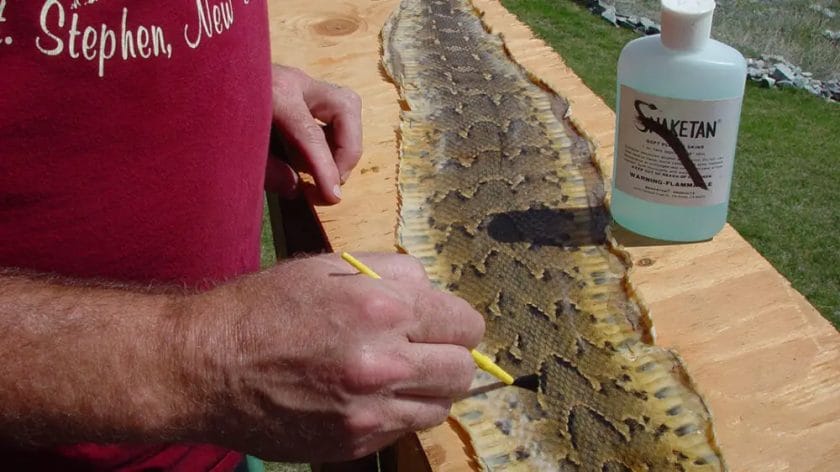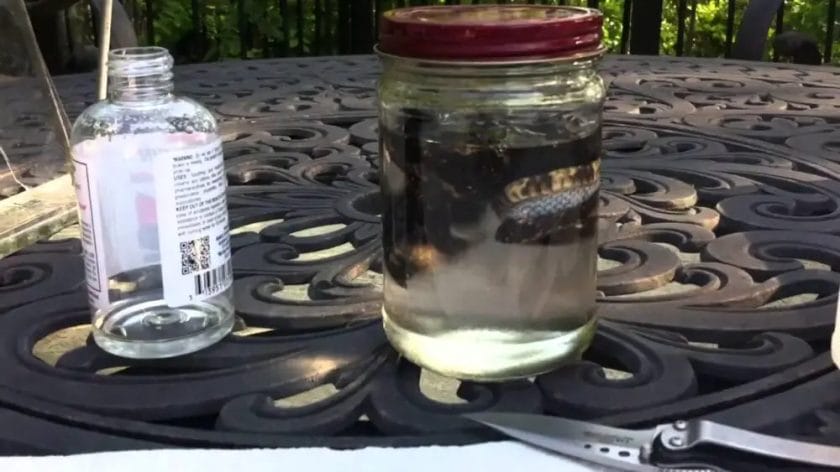Tanning snake skin at home can be a rewarding and cost-effective way to preserve and utilize this unique material. With just a few household items and simple techniques, you can achieve a beautifully tanned snake skin that is ready to be used for various crafts and projects.
By following a step-by-step process, which includes preparing the skin, treating it with a tanning solution, and then softening and conditioning it, you can transform raw snake skin into a flexible and durable material.
Using readily available items such as salt, baking soda, vinegar, and glycerin, you can create a homemade tanning solution that effectively preserves and colors the snake skin while maintaining its natural texture and appearance.
Whether you are an avid crafter, a lover of exotic fashion, or simply interested in exploring new DIY projects, tanning snake skin with household items offers you a unique opportunity to work with this fascinating material and create stunning pieces that showcase its natural beauty.

DIY Snake Skin Tanning Methods
Snake skins can be transformed into beautiful and unique materials that can be used for various purposes such as making accessories, clothing, or decorative items. Tanning snake skins preserves and strengthens the skin while giving it a soft and supple texture. While professional tanning services are available, there are also DIY methods that you can try at home to tan snake skins. In this section, we will explore some popular DIY snake skin tanning methods.
Method 1: Salt and Alum Tanning
This traditional method is widely used for tanning snake skins. Here’s how you can do it:
- Start by removing the flesh and any remaining scales from the snake skin. Use a blunt scraping tool to gently scrape off the flesh.
- Spread the skin on a flat surface, scales side down. Sprinkle a generous amount of non-iodized salt over the skin and rub it in to ensure even distribution.
- Leave the skin to dry for about 24 hours. This helps remove moisture and bacteria from the skin.
- After the drying period, remove the excess salt by gently shaking or brushing off the skin.
- In a separate container, mix alum powder with warm water until it dissolves completely.
- Immerse the snake skin in the alum solution and let it soak for about 24 hours. The alum helps preserve the skin and prevents it from decaying.
- After soaking, remove the skin and rinse it thoroughly with clean water to remove any excess alum.
- Stretch the skin on a flat surface and secure it with pins or clips. Leave it to air dry for a few days until it becomes fully dry and stiff.
Method 2: Vegetable Tanning
Another popular method for tanning snake skins is vegetable tanning. Here’s how you can do it:
- Remove the flesh and scales from the snake skin using a scraping tool.
- Prepare a vegetable tanning solution by boiling water and adding vegetable tanning agents such as tannin powder or bark extracts. Follow the instructions on the tanning agent’s packaging for the correct ratio.
- Immerse the snake skin in the tanning solution and let it soak for a few days. This allows the tannins to penetrate and tan the skin.
- After the soaking period, remove the skin from the solution and rinse it thoroughly with clean water.
- Stretch the skin on a flat surface and secure it with pins or clips. Allow it to dry naturally for several days until it becomes dry and flexible.
Method 3: Oil Tanning
If you prefer a softer and more supple texture for your tanned snake skin, you can try the oil tanning method. Here’s how:
- Remove the flesh and scales from the snake skin using a scraping tool.
- Heat a mixture of equal parts of neatsfoot oil and white spirit in a pot.
- Immerse the snake skin in the oil mixture and gently agitate it to ensure even penetration.
- Leave the skin in the oil mixture for several hours or overnight.
- After the oil tanning process, remove the skin from the mixture and gently squeeze out any excess oil.
- Stretch the skin on a flat surface and allow it to air dry for several days.
In summary, tanning snake skins requires careful preparation and patience. Whether you choose the salt and alum, vegetable tanning, or oil tanning method, always remember to follow the instructions carefully and take your time to achieve the desired results. Once tanned, your snake skin can be used creatively to add a touch of exotic beauty to your projects.

Easy and Affordable Household Items for Snake Skin Tanning
Tanning snake skins can be a fascinating and rewarding process. Whether you are an avid snake collector or simply interested in preserving the beauty of snake skins, there are several easy and affordable household items that you can use for tanning. In this section, we will explore some of these items and how you can utilize them to achieve excellent results.
1. Salt
Salt is a common household item that can be used for tanning snake skins. It helps to remove moisture from the skin and preserves it by preventing bacterial growth. To use salt for tanning, you will need to first remove the flesh from the skin and clean it thoroughly. Once cleaned, sprinkle a generous amount of salt onto the flesh side of the skin and let it sit for a few hours. The salt will absorb the moisture from the skin. After a few hours, shake off the excess salt and repeat the process until the skin is fully tanned.
2. Vinegar
Vinegar is another household item that can be used in the tanning process. It helps to soften the skin and prepare it for further treatment. After salting the snake skin, you can soak it in a mixture of vinegar and water for a few hours. The acidity of the vinegar helps to break down the proteins in the skin, making it more pliable and easier to work with. After soaking, rinse the skin thoroughly to remove any vinegar residue.
3. Glycerin
Glycerin is a versatile household item that can be used to condition and soften the tanned snake skin. After rinsing the skin, mix glycerin with water in a 1:1 ratio and apply it to the skin using a sponge or cloth. Gently massage the glycerin into the skin, paying special attention to any areas that may be stiff or dry. The glycerin will help to moisturize and soften the skin, giving it a supple and flexible texture.
4. Rubbing Alcohol
Rubbing alcohol can be used as a final step in the tanning process to disinfect the snake skin and remove any remaining impurities. After conditioning the skin with glycerin, dampen a clean cloth with rubbing alcohol and wipe down the skin, focusing on any areas that may require extra cleaning. The rubbing alcohol will help to kill any bacteria or fungi that may be present on the skin, ensuring its long-term preservation.
5. Olive Oil
Olive oil can be used as a natural and nourishing conditioner for tanned snake skins. After the skin has been treated with rubbing alcohol, apply a small amount of olive oil to a clean cloth and gently rub it onto the surface of the skin. The oil will help to restore moisture and give the skin a glossy finish. Be sure to use a minimal amount of oil, as excessive oil can make the skin greasy and attract dirt and dust.
By utilizing these easy and affordable household items, you can successfully tan snake skins and preserve their natural beauty. Remember to always handle snake skins with care and follow proper safety precautions during the tanning process. With a little patience and the right materials, you can create stunning pieces of art or decorative items using tanned snake skins.

Step-by-Step Guide to Tanning Snake Skin with Common Household Items
If you have come across a snake skin and want to preserve it, tanning is a great option. Tanning snake skin not only enhances its durability but also adds a unique touch to various craft projects. While the thought of tanning may seem daunting, it can actually be done using common household items. In this section, we will provide you with a step-by-step guide on how to tan snake skin easily.
Materials You Will Need
Before you begin the tanning process, gather the following materials:
- Snake skin
- Sharp knife or scalpel
- Borax powder
- Table salt
- Glycerin
- Paintbrush
- Plastic container with a lid
- Wooden board
- Clothespins or clamps
- Towel or sponge
Step 1: Prepare the Skin
Start by carefully removing the snake skin from the snake’s body. To do this, gently use a sharp knife or scalpel to make a small incision near the snake’s head and carefully peel the skin away. Take extra caution to avoid tearing or stretching the skin.
Step 2: Clean the Skin
Rinse the snake skin under cool water to remove any dirt or debris. Once clean, gently pat it dry with a towel or sponge. Be sure not to rub or apply excessive pressure to the skin, as this can damage the scales.
Step 3: Apply Borax and Salt
In a plastic container, mix equal parts borax powder and table salt. This mixture acts as a drying agent and helps remove any remaining moisture from the skin. Lay the snake skin flat on a wooden board and generously sprinkle the borax and salt mixture on both sides of the skin. Use a paintbrush to ensure an even distribution of the mixture.
Step 4: Let it Dry
Place the treated snake skin in a well-ventilated area away from direct sunlight. Allow it to dry for approximately 24 hours. During this time, the borax and salt mixture will absorb moisture from the skin, helping to prevent decay and preserve the quality of the skin.
Step 5: Apply Glycerin
After the skin has dried, it is time to soften it using glycerin. Glycerin helps restore flexibility and prevents the skin from becoming brittle. Using a paintbrush, apply a thin layer of glycerin evenly on both sides of the skin. Allow the glycerin to penetrate the skin for about 30 minutes.
Step 6: Stretch and Dry
Next, stretch the snake skin on a clean wooden board. Use clothespins or clamps to secure the edges of the skin onto the board. This stretching process helps prevent the skin from shrinking and curling as it dries. Leave the skin to dry completely in a well-ventilated area for approximately one week.
Step 7: Final Touches
Once the snake skin is dry, carefully remove it from the wooden board. Gently massage the skin to restore its suppleness. If desired, you can apply a protective finish or dye to enhance its appearance and durability.
In summary, tanning snake skin at home is a simple process that can be accomplished using common household items. By following this step-by-step guide, you can preserve the snake skin and use it for various crafts and projects. Remember to always handle the snake skin with care and take necessary precautions to avoid damage. Happy tanning!
Proven Techniques for Tanning Snake Skin using Everyday Items
Tanning snake skin can be a rewarding and fulfilling process that allows you to transform a raw snake hide into a beautiful, durable material. Whether you plan to use the tanned snake skin for crafting, fashion, or decorative purposes, it is essential to follow proven tanning techniques to achieve optimal results. In this section, we will explore some tried-and-tested methods for tanning snake skin using everyday items.
1. Salt and Alum Method
The salt and alum method is a popular technique for tanning snake skin and has been used for centuries. It requires a few basic household items such as salt, alum, water, and a non-reactive container.
Here is a step-by-step guide to tanning snake skin using the salt and alum method:
- Prepare the snake skin by removing any flesh or excess fat.
- Spread a layer of salt on both sides of the skin and leave it for 24 hours.
- After 24 hours, shake off the excess salt and rinse the skin under running water to remove any remaining salt.
- Prepare an alum solution by dissolving alum in warm water. The ratio should be around 1 pound of alum per gallon of water.
- Submerge the snake skin in the alum solution for about 3-4 hours.
- Remove the skin from the solution and rinse it thoroughly with clean water.
- Stretch the skin evenly and let it dry in a well-ventilated area away from direct sunlight.
- Once the skin is completely dry, massage a small amount of leather conditioner or oil into the skin to maintain its suppleness.
By following this method, you can achieve a soft and flexible tanned snake skin that is ready for various applications.
2. Egg Yolk and Oil Method
The egg yolk and oil method is another effective technique for tanning snake skin. This method involves using egg yolk, oil, and other common household items to preserve and soften the skin.
Here are the steps to tan snake skin using the egg yolk and oil method:
- Prepare the snake skin by removing any flesh or excess fat.
- In a bowl, mix together one egg yolk, one tablespoon of oil (such as olive oil or vegetable oil), and a pinch of salt.
- Apply the mixture to both sides of the snake skin and leave it for 24 hours.
- After 24 hours, rinse the skin under running water to remove any excess egg yolk mixture.
- Stretch the skin evenly and let it dry in a well-ventilated area.
- Once the skin is completely dry, apply a thin layer of leather conditioner or oil to keep it moisturized and pliable.
This method not only tans the snake skin but also imparts a subtle shine and softness to the material.
3. Alcohol and Glycerin Method
The alcohol and glycerin method is a simple yet effective technique for tanning snake skin. This method requires isopropyl alcohol, glycerin, water, and a non-reactive container.
Follow these steps to tan snake skin using the alcohol and glycerin method:
- Remove any flesh or fat from the snake skin.
- Mix equal parts of isopropyl alcohol, glycerin, and water in a non-reactive container.
- Submerge the snake skin in the mixture for about 5-7 days.
- After the designated time, remove the skin from the mixture and rinse it thoroughly with clean water.
- Gently stretch the skin and allow it to air-dry in a cool, shaded area.
- Apply a leather conditioner or oil to restore moisture and flexibility to the tanned skin.
This method yields a supple and durable tanned snake skin that is perfect for various crafts and projects.
In summary, tanning snake skin is a creative and engaging process that enables you to transform raw hides into beautiful and functional materials. By using everyday items such as salt, alum, egg yolk, oil, glycerin, and alcohol, you can successfully tan snake
FAQs
1. Can I tan snake skin using household items?
Yes, you can tan snake skin using household items. One common method is to use a mixture of salt and vinegar to remove the scales and preserve the skin. Another method involves using a solution of borax and water to tan the skin. However, it’s important to note that tanning snake skin requires careful handling and expertise.
2. What precautions should I take when tanning snake skin at home?
When tanning snake skin at home, it’s important to take some precautions. Make sure to wear gloves and protective eyewear to avoid any contact with chemicals. Additionally, work in a well-ventilated area to minimize exposure to fumes. Follow all safety instructions and guidelines provided with the tanning solution or method you choose.
3. Are there any alternative methods to tan snake skin?
Yes, there are alternative methods to tan snake skin. Some people prefer using commercial tanning kits specifically designed for reptile skins, as they provide more predictable results. If you’re unsure about tanning snake skin at home, it may be best to consult with a professional taxidermist or leather worker who has experience in working with exotic skins.
Conclusion
In conclusion, learning how to tan snake skin with household items can be a fascinating and budget-friendly way to preserve these exotic materials. By using common items found in your kitchen or bathroom, such as salt and vinegar, you can achieve professional-quality results without the need for expensive and specialized chemicals. Tanning snake skin allows you to create unique and durable products, like belts, wallets, or accessories, while also respecting the natural beauty and sustainability of snake populations. So, why not try your hand at snake skin tanning and embark on an exciting journey of creativity and self-sufficiency?
